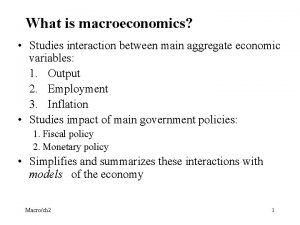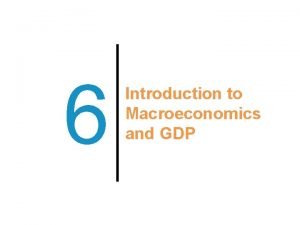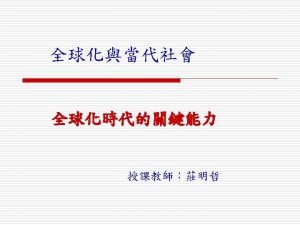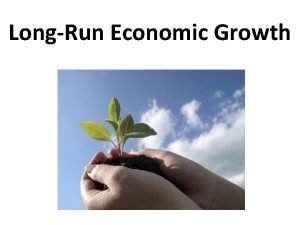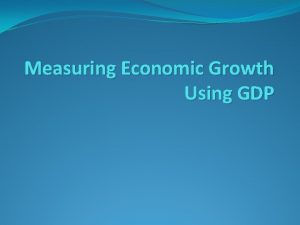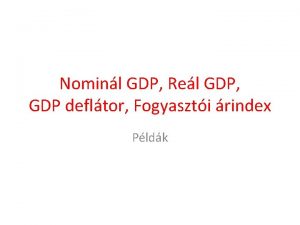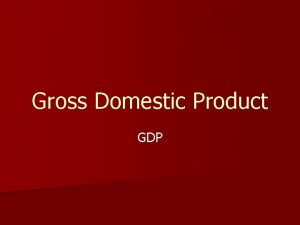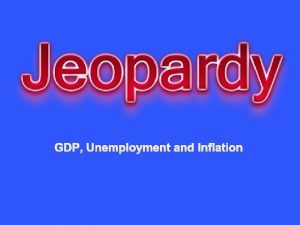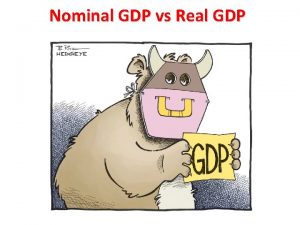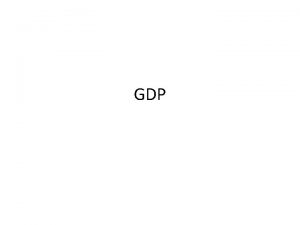Output GDP Economic Growth Mr OGrady Output GDP














- Slides: 14

Output, GDP & Economic Growth Mr O’Grady

Output & GDP Output: Quantity of goods & services produced in a given time period National Output: The total output of an entire economy Gross Domestic Product (GDP): The total value of all goods and services produced in one country over a one year period (UK GDP = $2. 74 tn (2019)-6 th largest in the world) Measures the size of an economy i. e. the value of transactions between economic agents. Why do we measure GDP? GDP per capita is used as a proxy to measure living standards. Higher GDP means more G&S are made. More G&S to go round means a better quality of life. GDP data allows comparisons of living standards between countries and track changes over time How do we measure GDP? There are three methods, all theoretically equal Expenditure Method: Adding up all the money spent in an economy in a year Income Method: Adding up all the money earned each year Output Method: Adding up all the value added (the difference between the value of what a firm puts out and what it takes in) by each firm each year How are these equal? Spending in an economy is equal to the value of everything sold, and therefore everything made (E=O). The income someone generates in a year, either for themselves or others, is equal to the value money their output brings from selling it (O=I). People spend what they earn (E=I) However: difficulties in estimating mean slight differences, so countries collect data via all three methods and publish an average (UK) or all three measures separately (USA)

Exclusions from GDP: Transfer payments: National Insurance, social security benefits and student grants from the government Private transfers of money from one individual to another: Pocket money/allowances from parents or an individual selling a second hand car Income not registered with the Inland Revenue: the ‘Hidden Economy’. Important Distinctions Real vs Nominal real values are adjusted for inflation, while nominal values are not. As a result, nominal GDP will often appear higher than real GDP. Total vs Per Capita Per capita GDP is a measure of the total output of a country that takes the gross domestic product (GDP) and divides it by the number of people in that country. The per capita GDP is especially useful when comparing one country to another, because it shows the relative performance of the countries. Value vs volume Volume refers to the real quantity of units of output produced in an economy (100, 000 cars + 20, 000 houses + …). Whereas the value of national income measures the monetary cost of all goods at current prices Value = volume x current price level


Alternate Measures of National Income: GNI & GNP Economic Growth Mr O’Grady

Alternate Measures of National Income: GNI & GNP GDP: The total value of all goods and services produced in one country over a one year period GNP (Gross National Product): GDP plus property income earned by the country's residents abroad (UK GNP = $2. 79 tn (2019)). GNI (Gross National Income): GDP plus wages, salaries, and property income of the country's residents earned abroad but spent domestically, net of income earned by foreign residents in the domestic country but spent overseas. (UK GNI = $3. 07 tn (2018)). Income Earned by: GDP GNI Residents in Country Includes (C+I+G+X) Includes Foreigners in Country Includes Excludes All Includes If Spent in Country Residents Out of Country Excludes Includes All Includes If Remitted Back Foreigners Out of Country Excludes Why collect GNP and GNI? They give a more inclusive measure of the income of a country and therefore a more accurate guide to living standards, particularly for country’s with large foreign receivables or outlays.

Limitations of GDP Economic Growth Mr O’Grady

Limitations of GDPas a measure of living standards … when making comparisons over time … when making comparisons between countries GDP doesn’t take into account population changes GDP per capita Doesn’t take into account inflation Real GDP / Real GDP per capita Quality of goods can change e. g. quality of a car 1950 s vs today Not Holistic - doesn’t account for all factors affecting living standards Ignores externalities / leisure/ pollution Inequality could have changed GDP per capita can be skewed by outlying statistics Nature of output that is being produced e. g. defence vs healthcare Statistical inaccuracies e. g. Ghana Consumption vs investment - Depends where the expenditure is and what are the long term gains, e. g. high consumption in the SR may drive GDP but saving to then investment will drive GDP and living standards in the LR Countries can manipulate data Inaccurate information Different proportions of spending e. g. Iceland spending on heating vs South Spain GDP doesn’t take into account population e. g. America vs China Hidden economy is a different proportion in each country e. g. UK vs Mexico Purchasing Power Parity exchange rate does not take into account the cost of living in each country Doesn’t take into account the quality of G&S being produced, just the value of production Differences in leisure time and hours worked per day e. g. USA 44 hours a week at work, Netherlands its 29 Considerations of the type of job e. g. miner vs bankers, job satisfaction

Purchasing Power Parity (PPP) Economic Growth Mr O’Grady

Purchasing Power Parity (PPP) Definition: a measurement comparing prices of specific goods in different areas, to contrast the absolute purchasing power of different currencies. PPP exchange rate: approximates the total adjustment that must be made on the currency exchange rate between countries that allows the exchange to be equal to the purchasing power of each country's currency. i. e. the exchange rate at which you could buy the same goods or services in both countries In Practice: If a hamburger sells in London for £ 2 but sells for $4 in New York, the implication is the PPP exchange rate is £ 1 is equivalent to $2 However, the actual GBP: USD exchange rate is closer to £ 1 : $1. 25 If you had $40 dollars in New York you could buy 10 burgers. Going to London and exchanging $40 would give you £ 32, enough to buy 16 burgers! A fixed amount of money goes further in the UK than it does in the USA. The Pound is undervalued against the Dollar. Implication: to compare living standards in different countries, we need to adjust for PPP so as to reflect how much people can actually buy with their incomes Where is life better: a country with GDP per capita of $20, 000 but a house costs $50, 000 or a country with GDP per capita of $50, 000 but a house costs $250, 000?

Happiness Economic Growth Mr O’Grady

The relationship between income and happiness Classical Economic Theory: higher income correlates to higher levels of utility (happiness) and economic welfare. Starting from a low base, increasing income means enables a person to buy more essential goods and services, the basics of life such as food, shelter, health care and education. This leads to an increased quality of life Easterlin Paradox: As GDP per capita rises, the gains to happiness of every extra bit of income quickly diminishes. One estimate is that an individual’s emotional well-being rose with earnings only up to a threshold of $75, 000 a year. Diminishing marginal utility of money: money in itself doesn’t bring any utility, but it is the consumption bought with the money that does. But as we consume more and more, each additional unit if consumption derives less satisfaction. 1 st glass of water vs 2 nd glass vs … vs 10 th glass. Why? There’s more to happiness than money! E. g. Quality of work, quality of consumption, leisure time, Welfare of family members, environment, social cohesion

National Happiness Definition: A subjective concept considering the welfare of a country’s citizens Measuring happiness: a combination of surveys asking people to self-assess their own happiness as well as measurable indices which affect broader welfare levels, e. g. levels of literacy, access to health care, political freedom, quantity of leisure, income levels and pollution levels. Gros National Happiness: a holistic measure including both traditional areas of socio-economic concern such as living standards, health and education and less traditional aspects of culture and psychological wellbeing. Bhutan & GNH: the government of Bhutan has been guided by a philosophy of trying to maximise GNH rather than GDP. In the last 20 years Bhutan has doubled life expectancy, enrolled almost 100% of its children in primary school and overhauled its infrastructure. Criticisms: The subjective nature of what factors to include in GNH has led has lead to it being labelled a propaganda tool. Not least because the ethnic cleansing of the non-Buddhist ethnic Nepalese population as a result of the GNH cultural preservation objective.

Where next? Visit our website: www. smootheconomics. co. uk Find more resources, enrichment materials, details of courses, competitions, and more! Find Our socials: You. Tube: Smooth Economics Instagram: @smootheconomics Twitter: @Smooth. Economics Facebook: @Smooth. Economics
 Economic growth vs economic development
Economic growth vs economic development Difference between economic growth and economic development
Difference between economic growth and economic development Nominal gdp
Nominal gdp What is included in gdp
What is included in gdp Gdp formula in macroeconomics
Gdp formula in macroeconomics Geometric growth vs exponential growth
Geometric growth vs exponential growth Carothers equation
Carothers equation Neoclassical growth theory vs. endogenous growth theory
Neoclassical growth theory vs. endogenous growth theory Primary growth and secondary growth in plants
Primary growth and secondary growth in plants Difference between organic and inorganic growth
Difference between organic and inorganic growth Relative growth rates
Relative growth rates Chapter 35 plant structure growth and development
Chapter 35 plant structure growth and development Root hair structure
Root hair structure Economics chapter 13 vocabulary
Economics chapter 13 vocabulary Economic growth occurs when
Economic growth occurs when


